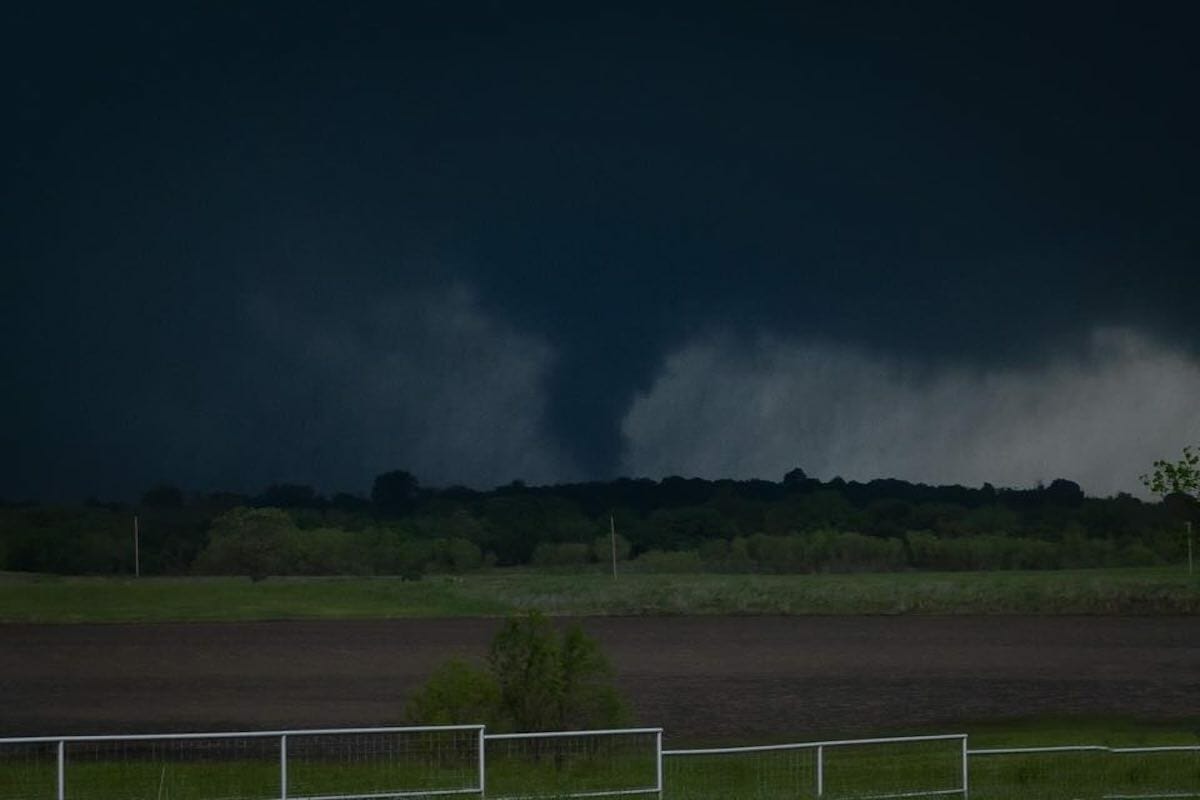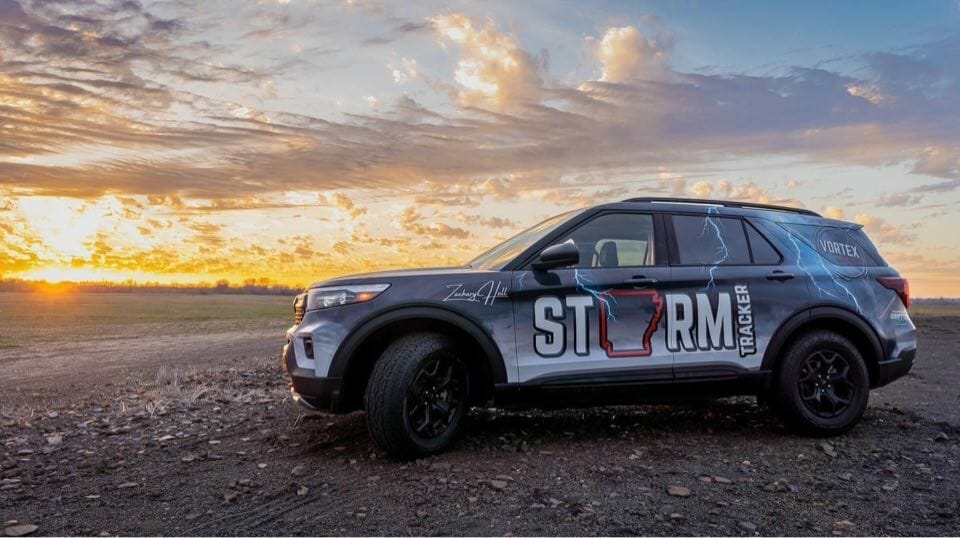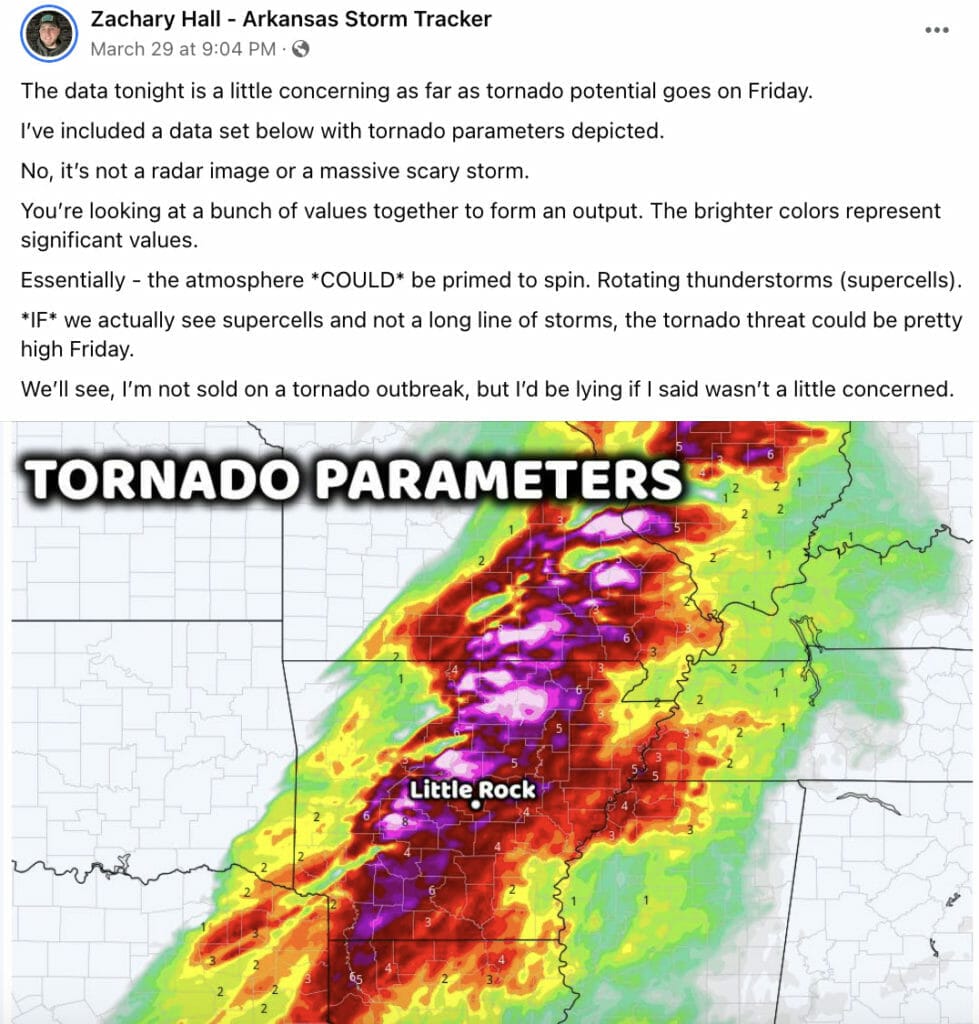

Uh oh...
It appears that you're using a severely outdated version of Safari on Windows. Many features won't work correctly, and functionality can't be guaranteed. Please try viewing this website in Edge, Mozilla, Chrome, or another modern browser. Sorry for any inconvenience this may have caused!
Read More about this safari issue.

Spring in Arkansas is lovely, but it also signals the official start of tornado season. Property damage can be devastating whenever a tornado strikes, but the loss of life is tragic and heartbreaking. Thanks to modern technology and a network of meteorologists and storm chasers, forecasting potential outbreaks and getting advanced warnings to the public are saving lives and keeping Arkansans safe.

Zachary Hall – Arkansas Storm Tracker, Frankie Shepherd and the Vortex Chasing crew are the eyes, ears and feet on the ground when storms strike. They are chasing the storms and reporting firsthand knowledge to keep Arkansans safe. During a recent well-earned lull in dangerous weather, I was able to catch up with Hall to find out precisely what happens when the tornado danger is significant and learn how he keeps the public safe and informed.
SKYWARN
A former police officer, Zachary Hall has always had a heart for public service and an interest in emergency management. His interest in severe weather and storm chasing began as a child, and Hall became a certified SKYWARN storm spotter in his teen years.
Along with nearly 400,000 annual volunteers across the United States, Hall learned how to spot storms safely in his area. Working closely with NOAA’s National Weather Service, SKYWARN storm spotters learn how to identify potential severe weather features that may not be picked up by radar and report them to the National Weather Service. Spotters are an essential tool for getting early warnings out to the public.
Are you interested in becoming a SKYWARM storm spotter? The volunteer training class is about two hours long. You can learn more and find local classes at weather.gov.
Fun Fact: In an average year, the United States experiences more than 10,000 severe thunderstorms, 5,000 floods and more than 1,000 tornadoes.

Storm Chasing
Although Hall enjoyed storm spotting, he felt called to do more. In his late teens and early twenties, Hall began planning vacations during storm season so he could join storm chases across the mid-west. As his knowledge and confidence grew, Hall began to venture out independently, chasing storms and reporting his observations on Facebook. Hall eventually left law enforcement to build a career out of storm chasing.
Although Hall has traveled all over the country chasing tornadoes, hurricanes and major snowstorms, his focus is on Arkansas. Hall spends each day monitoring the weather across Arkansas and keeping the public informed. When a significant weather event looms, Hall and his business partner Frankie Shepherd hit the road to report live from the field.
The Life of a Storm Chaser
On an average day, Hall begins by checking various weather models and interpreting data from several sources. While Hall looks at daily temperatures, rainfall, wind and cloud cover, he isn’t a meteorologist but has extensive background studies in meteorology and college education regarding emergency management. Hall doesn’t do the typical day to day rain forecast percentages like most news outlets. Instead, he focuses on large scale weather systems, specifically severe weather.
“My job is to make sure the public has ground truth.”
Weather forecasting has its downfalls which we have all seen with a missed forecast on our weather app or local news station. That is why Hall feels getting out into the weather is so important. Forecasts use simulated radar and high-resolution data to paint a big picture, while ground-level, in-the-moment reporting provides specific details.
5-7 Days Out
Hall checks weather models and data, looks at historical patterns, identifies potential severe systems that must be monitored closely, and makes initial contact with his nearly 200K Facebook followers regarding the possible storm.

The above image contains expired data.
2-3 Days Out
Hall continues monitoring data and begins to identify specific areas of the state where potential problems may occur. Hall typically releases several maps that may include risk levels and timing and warn about hail, possible flooding and tornado risk.

The above image contains expired data.
1 Day Out
While Hall continues to update the public on any timing issues or system updates, he and Shepherd will determine if they need to go into the field and will identify areas they will target with on-the-ground monitoring and reporting.
Chase Day
Chase day is exciting but also hectic. Shepherd drives the vehicle while Hall monitors data, updates their social media accounts and reports live on their YouTube Channel. Things can change in an instant, and they are always on the go, chasing storms until they can’t safely follow any further. As storms, especially those that spawn tornadoes, move across the state, Hall and Shepherd have to move in a manner to avoid traffic, avoid damage and debris and keep hopping from storm to storm. If they get stuck in an area, they lose their ability to continue reporting live conditions.
After the Storms
When the storms have finally cleared, Hall and Shepherd return to their home base in Northwest Arkansas, reflecting on the day as they drive. Each storm has a different yet profound effect.
Being in the middle of the storms, Hall and Shepherd are among the first to witness the damage, which takes an emotional toll. In the following days, rest is well deserved, but there is also a need to process what they saw. Emotions are high when storms hit close to home or there is a loss of life. There is also the adrenaline rush and the excitement of witnessing such incredible power so close.
Staying Safe In The Storm
Zachary Hall recognizes that sensational forecasts get clicks and views but can harm the public when reality sets in. Hall focuses on making regular updates to the public using measurable data rather than scare tactics. When a forecast goes wrong, the public loses faith in an information source, leaving them vulnerable when storms come. Hall is the first to admit when he makes a mistake, but his experience means those mistakes happen less and less.
Hall provides as much data and information as possible, but the public still plays a role in their safety. Following these steps make a life-or-death difference:
Have several ways to get weather updates from a local source like Zachary Hall.
1. Social Media
2. Use a battery-powered weather radio if you lose cell signal, internet or power.
3. Be weather aware, especially when storms are projected.
4. Have a safety plan. Know where you will go in a storm, ensure your shelter is clean and ready, and don’t ignore storm warnings.
Want to learn more about the weather in Arkansas? Check out these posts.
National Preparedness Month in Arkansas
Historic Weather Events in Arkansas
Experience a Tornado at the Museum of Discovery
Join the Conversation
Leave a Comment
One response to “Zachary Hall: Arkansas Storm Tracker”
 Leave a Reply
Leave a Reply
We do the work.
You check your email.
Sign up for our weekly e-news.
Get stories sent straight to your inbox!











 Leave a Reply
Leave a Reply
[…] Zachary Hall’s passion for helping others extends beyond storm tracking and sharing weather forecasts. Following the devastating northern Arkansas tornadoes in May, Zachary and Garrett Lewis from Oz Weather partnered to fill a gap for expedited storm recovery in Arkansas. Both guys wanted to do something quickly after seeing their followers request outlets to help. […]